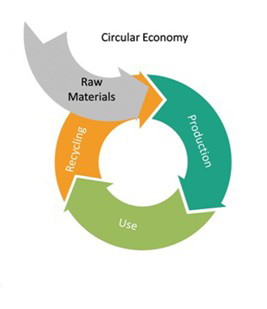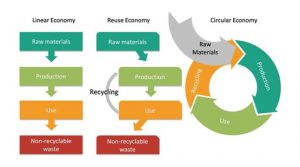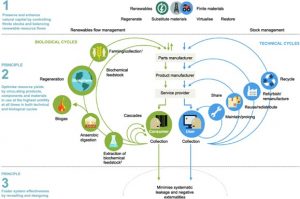
Circular Economy – Alternative VS Survival?

Article By: Ms. Thananan Jindakitskulchai
Marketing Expert in Industrial Sector
Circular Economy
Alternative VS Survival?
Three giant companies in the beverage industry: namely; Coca-Cola, Nestlé and Pepsi Co., are the subjects of questions that they are the origins of the enormous plastic wastes because drinks come with the plastic packaging. When the beverage business has grown, the plastic packaging would accordingly grow, the plastic wastes would simultaneously be increased. At a joint meeting of the United Nations Environment Program and the Ellen MacArthur Foundation in 2018, Coca-Cola, Nestlé and PepsiCo., and Fast Moving Consumer Goods (FMCG), and more than 200 other companies came to a mutual agreement by giving their commitments that full 100% of the company products will use reusable, recyclable, and compostable plastic containers within 2025.
Now that, What is the Circular Economy?
I am a kind of believing that we have begun to hear more about the term, “Circular Economy” and why leading international companies and leading companies in Thailand have started to adopt the Circular Economy into their business plans in order to strive to survivals and sustainability of their companies. We therefore need to understand what the Circular Economy is and how it can help the company to survive.
Over in the past, in the business sector, we focused on the productions for consumptions, on a large quantity necessarily requiring to produce up to the Economy of Scale. We place the emphasis very much on the productions with low costs and stimulations on consumers’ desires for increasing consumptions, thus, resulting in shorter product lifetimes. There is a change for target consumers towards more fashionable trend in order to increase demand. The consumptions being pushed by the manufacturers is a “Linear Economy” that merely focuses on the use of resources for the productions under the Take-Make-Dispose process consequently causing the enormous increase in the wastes while a lot of natural resources are used. According to the research reported in the World Business Council for Sustainable Development (WBCSD), natural resources at an increase of 300% were adopted for use over the past 40 years. It is expected that if the situation should continue to remain as it is, the demands would increase to 400% by 2050 which will result in the shortage of finite material sources. Therefore, the prices of finite materials, energy, lands, and water, will be more expensive or adequate in terms of the consumptions could give rise to the situation which would affect all sectors, the economy, society and security including garbage and pollutions that will affect the living systems, food chains and the public health of the people.
Over in the past several decades, we began to be familiar with the Reuse Economy that helps reduce quantity of wastes which destroy the environment to certain extent, Yet, the generated wastes cannot completely be made perished because some of the generated wastes cannot be reused consequently resulting in the ecosystem to be affected and the pollution to occur.
Circular Economy is a circular production system focusing the importance on the management of garbage and wastes from products after consumptions. It is the system allowing the use of resources with the maximum efficiency and enabling the used products to be taken back to the Make-Use-Return process again. The Circular Economy Principle is based on the product design in which the selections are made on the wastes and pollution derived from the materials of such product that can be used as raw materials for returning to nature in any way whatever. The concept of the Circular Economy is based on the concepts of Bio-mimicry, Eco-industry and the environmental design that follow the product life cycle from the pre-production to the post-usage by adhering to the Principle of Nature as the “Natural Blueprint” or in other words, Cradle to Cradle (C2C) Design. The Circular Economy is therefore the production system without any wastes because the wastes derived from one business can be adopted for use as the source raw materials of another business continuously.

The Principle of Circular Economy is Based on 3 Principles which are: (See the Butterfly Diagram)
Principle 1) – Preserve and enhance natural capital by controlling finite stocks and balancing renewable resource flows.
Principle 2) – Optimize resource yields by circulating products, components and materials in use at the highest utility at all times in both “Technical and Biological Circles” begin from the product design. The emphasis is placed on the reductions in the wastes and the compatibility with the biological chain that can easily be decomposed and must not contain any toxic substances. The products must be long-lasting for use, under the conditions for remanufacturing, refurbishing, repair, maintenance, worthy reuse, recycling, up-cycling by adding value, inserting new idea and beauty into things about to becoming rubbish. The product design is therefore the most important thing which must be focused on a non-cause of any wastes leakage from the production system, making the products being durable, creating resilience through diversities with the property of a modularity and can be used again by using the least energy yet can still maintain the highest quality.
Principle 3) – Foster system effectiveness by designing to minimize systematic leakage and avoid the negative externalities from the products as much as possible to prevent the wastes from slipping out of the system.

There are many documented academic details related to Circular Economy. Please let me mentioned primarily as the introduction to enable readers to understand the basic Principle Circular Economy from the point of view of marketers. It is necessary to educate consumers to be awared of the importance of the change in the consumption behaviors and to give a perspective view on the opportunity for a change in doing business on joint participations in creating a green economy in Thailand initiated within the company carrying on the development of the Circular Economy. It may be in the form of the fragmented transition to Circular Econom expanded to be the circularity in closed supply chains, which develops the concept of the Circular Economy to other companies in the same demand chain to increase the company’s competitiveness. It can expand the level of the Circular Economy concept at the Ecosystem (Circularity in closed ecosystem) to be the development of the whole system at both the private and government levels, where the co-operations of both the private and public sectors are necessarily required. In addition, the government horizontal policy which integrates the policies shall continuously be related across the ministries, departments, divisions and agencies of the government in the researches and developments of the materials, merchantable products, product standards and environments. In Thailand, we began to obviously see that many government agencies, i. e. Pollution Control Department, has implemented a roadmap for managing and disposing of the plastic wastes. The Ministry of Industry’s policy and the government’s Policy on Bio Economy, Circular Economy, Green Economy, have focused on solving the grass roots economic problems or the biological economy on the effective and worthwhile use of resources by taking in to account in bringing various materials for reuse for maximum benefits as much as possible. The aim is at solving pollution problems, sustainably reducing the environmental impacts by developing economy for stable growth. TISI has announced the use of Circular Economy (CE) standard or the standard on the use of the Principle of the Circular Economy in the organizations, which is Standard No. 2-2562. We are still looking for the government policy that may be on the aspect of the Green Tax, Free zone, all along with the supportively funding sources, low interest rates or an opening of the opportunity to mobilize funds in Green Bond. All these things will facilitate investments in the private sector or newly emerged entrepreneurs who want to invest in the business being or relating to the Circular Economy because of high production costs of the products being environmental friendly the environmentally friendly. So, if the production costs can be reduced to a reasonable and balancing levels that both the manufacturers can produce and the consumers can afford. It will be no doubt that Thailand can successfully achieve the fruitful expectation in the development of the Circular Economy for the Economic Sustainability in the end.


